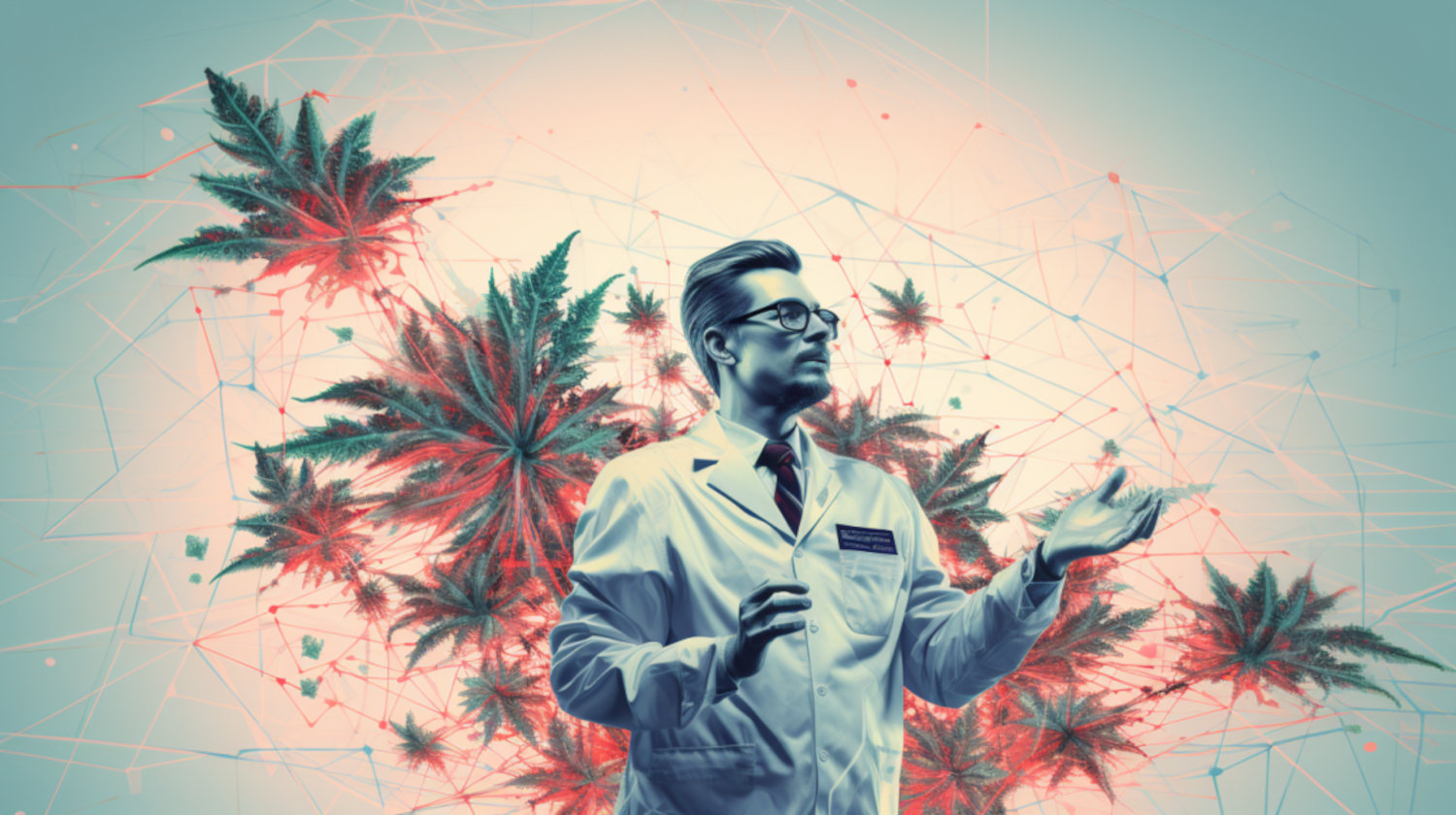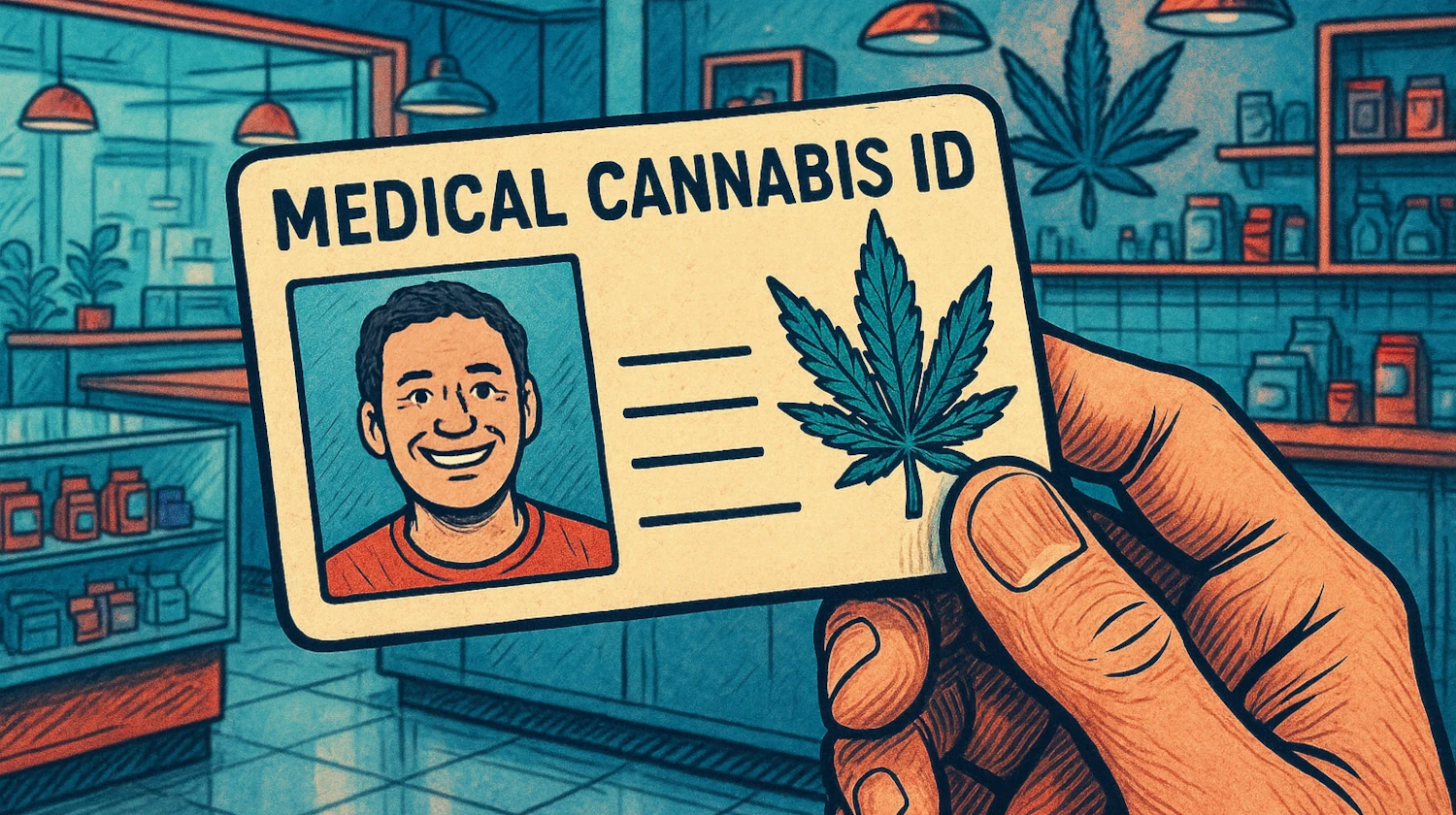In This Article
- What Causes COVID-19 Infection?
- Signs You May Have COVID
- Preventing COVID-19 Infection
- COVID-19 Vaccination
- Medical Cannabis
- How Cannabis Interacts with COVID-19
- Top Cannabinoids Associated with COVID-19
- Cannabis Products Most Often Used for COVID-19
- Side Effects of Medical Marijuana for COVID-19 Patients
- Possible Positive Side Effects of MMJ for COVID-19
- Possible Negative Side Effects of MMJ for COVID-19
- Limitations of Treating COVID-19 with Medical Cannabis
- Which States Allow Cannabis for COVID-19?
- Is it safer to eat edibles than to smoke marijuana if coping with COVID?
- Is a COVID-19 infection an eligible medical condition for a cannabis med card?
- Is it wise to share a joint with an individual who has previously tested positive for COVID-19?
- How and where is it possible to buy marijuana during the pandemic?
- Is the cannabis industry affected by the global supply chain crisis?
- Will using cannabis help with COVID-related anxiety or depression?
- Are there ways to socially smoke while still reducing the risk of exposure to COVID-19?
- Resources
SARS-CoV-2, a novel coronavirus, is a highly infectious virus that first emerged in Wuhan, China. It first appeared in the final months of 2019, but it wasn’t until January 2020 that it was first detected. Infection of the virus causes a respiratory disease commonly known as COVID-19 (coronavirus disease 2019).
While the symptoms of COVID-19 primarily affect the respiratory system, it is not merely a respiratory infection. It can cause a range of effects, such as dry cough, congestion, digestive issues, and a characteristic loss of taste and smell. After exposure to the virus, fever, fatigue, and muscle aches are typically the first symptoms.
According to the World Health Organization (WHO), as of August 11th, 2024, medical officials have reported over 775 million confirmed cases and over 7 million deaths attributed to COVID-19 infection.
Many governments worldwide implemented a wide range of public health policies to slow the spread of the virus. The most significant of which have been isolation while sick, social distancing in public, and masking.
Please note that all the information we present in our article below is for educational purposes only and is not a substitute for professional legal or medical advice.
What Causes COVID-19 Infection?

A COVID-19 infection is caused by exposure to the SARS-CoV-2 coronavirus. SARS-CoV-2 is an airborne virus.
In many cases, COVID-19 is spread by heavy respiratory droplets that others can breathe in. These droplets can also land on the eyes, noses, or mouths of those nearby, transmitting the virus in the process. What spreads these respiratory droplets the most is coughing, sneezing, talking, and breathing.
Lighter respiratory droplets can also linger in the air for several minutes or even hours. This is particularly true in poorly ventilated and enclosed spaces.
The CDC states that it is also possible for viral droplets to contaminate surfaces and high-touch areas, spreading to people's hands. From there, they may touch their nose or mouth, exposing themselves to the virus.
It may be difficult or impossible for medical professionals to specify how a patient was infected by COVID-19. However, with proper contact tracing procedures, it may be possible to determine where or by whom an individual was infected.
Signs You May Have COVID
Symptoms of a COVID-19 infection can mimic many other common illnesses, such as a cold or the flu. As such, it may not be possible to diagnose yourself in the event of infection.
If you start to exhibit some of the characteristic signs of COVID-19, you should seek a COVID test as soon as possible. The most common symptoms include the following:
- Fever
- Cough
- Fatigue
- Shortness of breath or difficulty breathing
A COVID-19 infection may also cause some other less common symptoms. These may include:
- Loss of taste or smell
- Nasal congestion
- Muscle or joint pain
- Conjunctivitis (red eyes)
- Sore throat
- Headache
- Different types of skin rash
- Nausea or vomiting
- Diarrhea
No matter your age or previous medical condition(s), you should seek medical attention as soon as possible if you are experiencing symptoms of a severe COVID-19 infection. And don’t hesitate to contact your healthcare provider or physician if you are unsure if additional medical attention is necessary for your COVID-19 infection.
People of all ages who experience fever and/or cough associated with difficulty breathing, shortness of breath, chest pain or pressure, or loss of speech or movement should seek medical care immediately. If possible, call your healthcare provider, hotline, or health facility first so you can be directed to the right clinic.
Preventing COVID-19 Infection

There are many ways to protect yourself and others from COVID-19 exposure. However, the CDC recommends taking the following precautions to avoid exposure to COVID-19 and protect others from infection.
- Stay up to date with COVID-19 vaccines.
- Wear a mask (a KN95 or NIOSH-approved N95 mask, if possible) while in crowded spaces, particularly those with poor-ventilation.
- Stay home if you are sick and self-isolate from other household members.
- Practice good hygiene, washing your hands with hot water and antibacterial soap after touching high-touch areas and before touching your face or eating food.
- If you or others in your household begin to feel symptoms or have had contact with a COVID-19-positive patient, be sure to take a test as soon as possible to prevent spreading it to others.
- Frequently clean or disinfect surfaces that are often touched.
COVID-19 Vaccination
As of August 2024, updated vaccines are available for the current COVID-19 variants, with the most common developed by pharmaceutical companies Pfizer and Moderna.
When it comes to SARS-CoV-2, the most common COVID-19 vaccines are made with mRNA, which tells your body how to make certain proteins. More specifically, mRNA teaches your body how to replicate the COVID-19 spike protein, so if you are exposed your body can recognize the virus and know how to defend itself.
Medical Cannabis
Early in the pandemic, there was much speculation regarding cannabis use and COVID-19. However, it wasn’t until a 2022 study was published in the Journal of Natural Products that researchers took cannabinoids as a treatment option for COVID-19 seriously. This study found that particular cannabinoid acids (CBDA and CBGA) could make it more difficult for SARS-CoV-2 and its emerging variants to infiltrate cells. This suggests that medical cannabis use could make it harder to become infected if these results are accurate.1
Despite how exciting these early findings may appear, studies conducted around cannabis and SARS-CoV-2 are in the preliminary stages and are NOT proof that cannabis can prevent or treat infection. As such, consumers should not presume that using cannabis can help avoid or treat symptoms of a COVID-19 infection. Not only that, smoking and vaping can cause irritation in the lungs. This irritation could make consumers more susceptible to the virus, worsen respiratory symptoms in the case of infection, and increase the likelihood the virus will spread as a result of increased coughing. If you are concerned about such risks, it is recommended that you limit your cannabis use to edibles or tinctures.
How Cannabis Interacts with COVID-19
First and foremost, COVID-19 spreads through the body because of the spike proteins on the surface of the SARS-CoV-2 virus. According to one study by Oregon State University, two cannabinoids in marijuana also bind to COVID-19 spike proteins. Researchers found that cannabidiol acid (CBDA) and cannabigerol acid (CBGA) could attach to these proteins within tissue cultures. These findings suggest that these cannabinoids could make it more difficult for SARS-CoV-2 to attach to cells and spread throughout the body.1
Nevertheless, research results seen in tissue cultures in the lab do not necessarily extend to the human body. Many more studies are needed before any definitive conclusions can be drawn.
In most cases, severe COVID-19 infections that ultimately lead to death are due to cytokine storms. Cytokine storms are the result of an overactive immune response; they cause such severe inflammation that it overwhelms the body and, if left unchecked, can lead to death. Some studies have suggested that cannabinoids such as THC and CBD can reduce the inflammation caused by these cytokine storms. A 2020 Augusta University study demonstrated that cannabidiol (CBD) can also help reduce the severity of the cytokine storm in general.2
Despite these promising early findings, there is not enough data to indicate a clear link between cannabis use and COVID-19 prevention. Scientists continue to study the potential applications of cannabinoids in the treatment and prevention of COVID-19, but for now, consumers should NOT assume that cannabis use will help protect them from infection or alleviate severe symptoms of coronavirus.
Read more about our exploration into early internet rumors about cannabis and coronavirus.
Top Cannabinoids Associated with COVID-19
These cannabinoids have shown the most promise in early studies, but the following results are not proof that they can be used – particularly in the quantities found in commercial cannabis products – to either prevent COVID-19 infection or treat its symptoms.
CBDA and CBGA
Researchers at Oregon State University found that CBDA and CBGA can bind to the spike proteins of SARS-CoV-2, making it more difficult for the virus to spread in the body.1
CBD
CBD is known for its anti-inflammatory effects. As such, researchers have high hopes that it can help alleviate the potentially fatal inflammation that occurs during cytokine storms.2
Delta-9 THC
The use of Delta-9 THC in mice demonstrated decreased lung inflammation and mortality rate resulting from a cytokine storm.3
Cannabis Products Most Often Used for COVID-19
At this time, there are no cannabis products of any kind that are formally approved for treating COVID-19 or its underlying symptoms.
Consumers who wish to try using cannabis and worry about potential side effects like lung irritation should limit their usage to edibles and transdermal options rather than inhaling harsh smoke or vapor.
Side Effects of Medical Marijuana for COVID-19 Patients
There are many possible side effects of using cannabis as a COVID-19 patient. These effects vary depending on the individual's background, their experience with cannabis, and the product they use.
It should also be remembered that cannabis products high in THC content may increase the severity of both positive and negative side effects.
Possible Positive Side Effects of MMJ for COVID-19
- Anxiety relief: There are many distressing elements of the COVID-19 pandemic. Fears over your health and finances, along with the effects of social isolation, could potentially be alleviated by medical marijuana use.
- Improved sleep: In addition to feelings of anxiety, pandemic fears can wreak havoc on the length and quality of sleep. Many MMJ patients point to improved sleep as a reason for their use.
- Appetite booster: COVID-19 infections can affect the sense of smell and taste, leading to reduced appetite. Cannabis is used by many medical patients to help reduce nausea and stimulate appetite.
Possible Negative Side Effects of MMJ for COVID-19
- Lung/Throat irritation: Smoking or vaping medical marijuana can lead to irritation of the lungs or throat. This could be dangerous if COVID-19 infection is already causing difficulty breathing or if you are concerned about spreading the virus through airborne droplets as you cough.
- Feelings of anxiety or paranoia: Marijuana does not always lead to feelings of calm and relaxation. In fact, certain strains or highly potent products can cause anxiety in some consumers.
Limitations of Treating COVID-19 with Medical Cannabis
Despite some promising early studies, there is still so much we don’t know about the relationship between cannabis consumption and COVID-19. Consumers must remember that medical cannabis is not a currently approved method of prevention or treatment for COVID-19 infection.
While THC and CBD products have demonstrated anti-inflammatory potential, their role in treating cytokine storms is still unproven.
And because smoking or vaping medical marijuana can cause irritation of the lungs and throat, many healthcare professionals advise avoiding cannabis consumption as a way to help stave off infection and reduce the severity of related symptoms.
Lastly, and most importantly, consumers should avoid any social smoking – especially in enclosed areas – or sharing of medical marijuana (including pipes, bongs, and pre-rolls). Contact with others always carries an increased risk of COVID-19 exposure.
Which States Allow Cannabis for COVID-19?
No states directly state COVID-19 as a qualifying condition for medical cannabis. Some states leave the decision up to the evaluating physician, but it is unlikely they would recommend cannabis as a treatment given the potential lung irritation and short infection duration.
If you are looking to determine if you qualify for medical cannabis as a result of a COVID-19 infection, visit your state’s medical marijuana program website to learn more.
Is it safer to eat edibles than to smoke marijuana if coping with COVID?
When considering COVID-19, yes, it is safer to eat edibles rather than smoke. There is no irritation of the lungs and airways when consuming edibles, and you will be less likely to share a product with another consumer.
Is a COVID-19 infection an eligible medical condition for a cannabis med card?
At this time, no, a diagnosis of COVID-19 is not a qualifying condition for a medical marijuana card. Though some states do not have a formal list of qualifying conditions, it is highly improbable that an evaluating physician would recommend medical marijuana for COVID-19. Even so, a COVID-19 infection does not last for that long (a few weeks, at the most). This means your qualifying condition (and MMJ eligibility) would expire within a short window.
Is it wise to share a joint with an individual who has previously tested positive for COVID-19?
No. This is not recommended, as it is still possible for new COVID variants to spread, even in vaccinated or previously infected individuals.
How and where is it possible to buy marijuana during the pandemic?
Many legal dispensaries allow customers to order online and deliver their products home. Customers can reserve their order for fast pickup (either curbside or in-store) if no delivery option is available. Depending on your state, a marijuana subscription service could also be available.
Is the cannabis industry affected by the global supply chain crisis?
The global supply chain crisis has affected nearly every industry and product. However, medical marijuana, by law, must be grown and distributed in the same state it is sold. This means that the cannabis industry has not been severely impacted by global supply chain disruptions. Therefore, consumers should not necessarily see a significant decrease in the availability of local cannabis.
Will using cannabis help with COVID-related anxiety or depression?
Anecdotally speaking, many patients have found that using cannabis products alleviates some of the psychological effects of the COVID-19 pandemic and its related issues.
Are there ways to socially smoke while still reducing the risk of exposure to COVID-19?
While smoking marijuana with others still carries significant risks of infection, there are ways to reduce this risk. There are specially designed mouthpieces for bongs and vapes that can be removed and re-attached to minimize the risk of spreading the virus. Nevertheless, these mouthpieces are not 100% effective, and you can still become infected while smoking with or near others.
Ultimately, the only way to completely eradicate the risk of exposure is to avoid smoking with others.
Resources
- van Breemen RB, Muchiri RN, Bates TA, et al. Cannabinoids Block Cellular Entry of SARS-CoV-2 and the Emerging Variants. J Nat Prod. 2022;85(1):176-184. doi:10.1021/acs.jnatprod.1c00946 ↩︎
- Khodadadi H, Salles ÉL, Jarrahi A, et al. Cannabidiol Modulates Cytokine Storm in Acute Respiratory Distress Syndrome Induced by Simulated Viral Infection Using Synthetic RNA. Cannabis Cannabinoid Res. 2020;5(3):197-201. Published 2020 Sep 2. doi:10.1089/can.2020.0043 ↩︎
- Mohammed A, F K Alghetaa H, Miranda K, et al. Δ9-Tetrahydrocannabinol Prevents Mortality from Acute Respiratory Distress Syndrome through the Induction of Apoptosis in Immune Cells, Leading to Cytokine Storm Suppression. Int J Mol Sci. 2020;21(17):6244. Published 2020 Aug 28. doi:10.3390/ijms21176244 ↩︎
The information in this article and any included images or charts are for educational purposes only. This information is neither a substitute for, nor does it replace, professional legal advice or medical advice, diagnosis, or treatment. If you have any concerns or questions about laws, regulations, or your health, you should always consult with an attorney, physician or other licensed professional.




